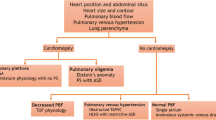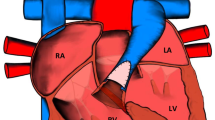Abstract
Congenital heart disease affects approximately 1% of live births per year. In recent years, there has been a decrease in the morbidity and mortality of these cases due to advances in medical and surgical care. Imaging plays a key role in the management of these children, with chest radiography, echocardiography and chest ultrasound the first diagnostic tools, and cardiac computed tomography, catheterization and magnetic resonance imaging reserved to assess better the anatomy and physiology of the most complex cases. This article is a beginner’s guide to the anatomy of the most frequent congenital heart diseases (atrial and ventricular septal defects, abnormal pulmonary venous connections, univentricular heart, tetralogy of Fallot, transposition of the great arteries and coarctation of the aorta), their surgical management, the most common postsurgical complications, deciding which imaging modality is needed, and when and how to image gently.

















Similar content being viewed by others
References
Di Salvo G, Miller O, Babu Narayan S et al (2018) Imaging the adult with congenital heart disease: a multimodality imaging approach - position paper from the EACVI. Eur Heart J Cardiovasc Imaging 19:1077–1098
Aguet J, Seed M, Marini D (2020) Fetal cardiovascular magnetic resonance imaging. Pediatr Radiol 50:1881–1894
Mcleod G, Shum K, Gupta T et al (2018) Echocardiography in congenital heart disease. Prog Cardiovasc Dis 61:468–475
Kellenberger CJ, Yoo S-J, Büchel Valsangiacomo ER (2007) Cardiovascular MR imaging in neonates and infants with congenital heart disease. Radiographics 27:5–18
Krishnamurthy R (2010) Neonatal cardiac imaging. Pediatr Radiol 40:518–527
Ramirez-Suarez KI, Tierradentro-García LO, Otero HJ et al (2022) Optimizing neonatal cardiac imaging (magnetic resonance/computed tomography). Pediatr Radiol 52:661–675
Francone M, Gimelli A, Budde RPJ et al (2022) Radiation safety for cardiovascular computed tomography imaging in paediatric cardiology: a joint expert consensus document of the EACVI, ESCR, AEPC, and ESPR. Eur Heart J Cardiovasc Imaging 23:e279–e289
Driessen MMP, Breur JMPJ, Budde RPJ et al (2015) Advances in cardiac magnetic resonance imaging of congenital heart disease. Pediatr Radiol 45:5–19
Shaddy RE, Penny D, Feltes TF et al (2021) Moss & Adams’ heart disease in infants, children, adolescents: including the fetus and young adult, 10th edn. Lippincott Williams & Wilkins
Ciancarella P, Ciliberti P, Santangelo TP et al (2020) Noninvasive imaging of congenital cardiovascular defects. Radiol Med 125:1167–1185
Pontone G, Di Cesare E, Castelletti S et al (2021) Appropriate use criteria for cardiovascular magnetic resonance imaging (CMR): SIC—SIRM position paper part 1 (ischemic and congenital heart diseases, cardio-oncology, cardiac masses and heart transplant). Radiol Med 126:365–379
Francone M, Aquaro GD, Barison A et al (2021) Appropriate use criteria for cardiovascular MRI: SIC – SIRM position paper Part 2 (myocarditis, pericardial disease, cardiomyopathies and valvular heart disease). J Cardiovasc Med 22:515–529
McLennan DI, Solano ECR, Handler SS et al (2021) Pulmonary vein stenosis: moving from past pessimism to future optimism. Front Pediatr 9:747812
Grosse-Wortmann L, Al-Otay A, Woo Goo H et al (2007) Anatomical and functional evaluation of pulmonary veins in children by magnetic resonance imaging. J Am Coll Cardiol 49:993–1002
Lam CZ, Nguyen ET, Yoo SJ, Wald RM (2022) Management of patients with single-ventricle physiology across the lifespan: contributions from magnetic resonance and computed tomography imaging. Can J Cardiol 38:946–962
Secinaro A, Ait-Ali L, Curione D et al (2022) Recommendations for cardiovascular magnetic resonance and computed tomography in congenital heart disease: a consensus paper from the CMR/CCT working group of the Italian Society of Pediatric Cardiology (SICP) and the Italian College of Cardiac Radiology. Radiol Med 127:788–802
de Lange C (2020) Imaging of complications following Fontan circulation in children - diagnosis and surveillance. Pediatr Radiol 50:1333–1348
Secinaro A, Curione D, Mortensen KH et al (2019) Dual-source computed tomography coronary artery imaging in children. Pediatr Radiol 49:1823–1839
Caro-Dominguez P, Chaturvedi R, Chavhan G et al (2019) Magnetic resonance imaging assessment of blood flow distribution in fenestrated and completed fontan circulation with special emphasis on abdominal blood flow. Korean J Radiol 20:1186–1194
Grosse-Wortmann L, Al-Otay A, Yoo S-J (2009) Aortopulmonary collaterals after bidirectional cavopulmonary connection or Fontan completion quantification with MRI. Circ Cardiovasc Imaging 2:219–225
Khanna G, Bhalla S, Krishnamurthy R, Canter C (2012) Extracardiac complications of the Fontan circuit. Pediatr Radiol 42:233–241
Dillman JR, Trout AT, Alsaied T et al (2020) Imaging of Fontan-associated liver disease. Pediatr Radiol 50:1528–1541
van der Ven JPG, van den Bosch E, Bogers AJCC, Helbing WA (2019) Current outcomes and treatment of tetralogy of Fallot. F1000Res 28:F1000 Faculty Rev-1530
Valente AM, Cook S, Festa P et al (2014) Multimodality imaging guidelines for patients with repaired tetralogy of fallot: a report from the American Society of Echocardiography: Developed in collaboration with the Society for Cardiovascular Magnetic Resonance and the Society for Pediatric Radiology. J Am Soc Echocardiogr 27:111–141
Zucker EJ (2021) Computed tomography in tetralogy of Fallot: pre- and postoperative imaging evaluation. Pediatr Radiol. https://doi.org/10.1007/S00247-021-05179-5
Norton KI, Tong C, Glass RBJ, Nielsen JC (2006) Cardiac MR imaging assessment following tetralogy of fallot repair. Radiographics 26:197–211
Yim D, Riesenkampff E, Caro-Dominguez P et al (2017) Assessment of diffuse ventricular myocardial fibrosis using native T1 in children with repaired tetralogy of Fallot. Circ Cardiovasc Imaging 10:e005695
Geva T, Sandweiss BM, Gauvreau K et al (2004) Factors associated with impaired clinical status in long-term survivors of tetralogy of Fallot repair evaluated by magnetic resonance imaging. J Am Coll Cardiol 43:1068–1074
Ali LA, Gentili F, Festa P et al (2021) Long-term assessment of clinical outcomes and disease progression in patients with corrected tetralogy of Fallot. Eur Rev Med Pharmacol Sci 25:6300–6310
Cohen MS, Eidem BW, Cetta F et al (2016) Multimodality imaging guidelines of patients with transposition of the great arteries: a report from the American society of echocardiography developed in collaboration with the society for cardiovascular magnetic resonance and the society of cardiovascular computed tomography. J Am Soc Echocardiogr 29:571–621
Ntsinjana HN, Tann O, Hughes M et al (2017) Utility of adenosine stress perfusion CMR to assess paediatric coronary artery disease. Eur Heart J Cardiovasc Imaging 18:898–905
Losay J, Touchot A, Serraf A et al (2001) Late outcome after arterial switch operation for transposition of the great arteries. Circulation 104:I-121–I-126
Legendre A, Losay J, Touchot-Kone A et al (2003) Coronary events after arterial switch operation for transposition of the great arteries. Circulation 108(Suppl 1):II186–II190
Schwartz ML, Gauvreau K, del Nido P et al (2004) Long-term predictors of aortic root dilation and aortic regurgitation after arterial switch operation. Circulation 110(11 Suppl 1):II128–II32
Araoz PA, Reddy GP, Tarnoff H et al (2003) MR findings of collateral circulation are more accurate measures of hemodynamic significance than arm-leg blood pressure gradient after repair of coarctation of the aorta. J Magn Reson Imaging 17:177–183
Hom JJ, Ordovas K, Reddy GP (2008) Velocity-encoded cine MR imaging in aortic coarctation: functional assessment of hemodynamic events. Radiographics 28:407–416
Gallego P, Valverde I (2021) Multimodality imaging innovations in adult congenital heart disease. Springer
Velasco Forte MN, Hussain T, Roest A et al (2019) Living the heart in three dimensions: applications of 3D printing in CHD. Cardiol Young 29:733–743
Chen C, Quin C, Qiu H et al (2020) Deep learning for cardiac image segmentation: a review. Front Cardiovasc Med 7:25
Author information
Authors and Affiliations
Corresponding author
Ethics declarations
Conflicts of interest
None
Additional information
Publisher's Note
Springer Nature remains neutral with regard to jurisdictional claims in published maps and institutional affiliations.
Rights and permissions
Springer Nature or its licensor (e.g. a society or other partner) holds exclusive rights to this article under a publishing agreement with the author(s) or other rightsholder(s); author self-archiving of the accepted manuscript version of this article is solely governed by the terms of such publishing agreement and applicable law.
About this article
Cite this article
Caro-Domínguez, P., Secinaro, A., Valverde, I. et al. Imaging and surgical management of congenital heart diseases. Pediatr Radiol 53, 677–694 (2023). https://doi.org/10.1007/s00247-022-05536-y
Received:
Revised:
Accepted:
Published:
Issue Date:
DOI: https://doi.org/10.1007/s00247-022-05536-y




